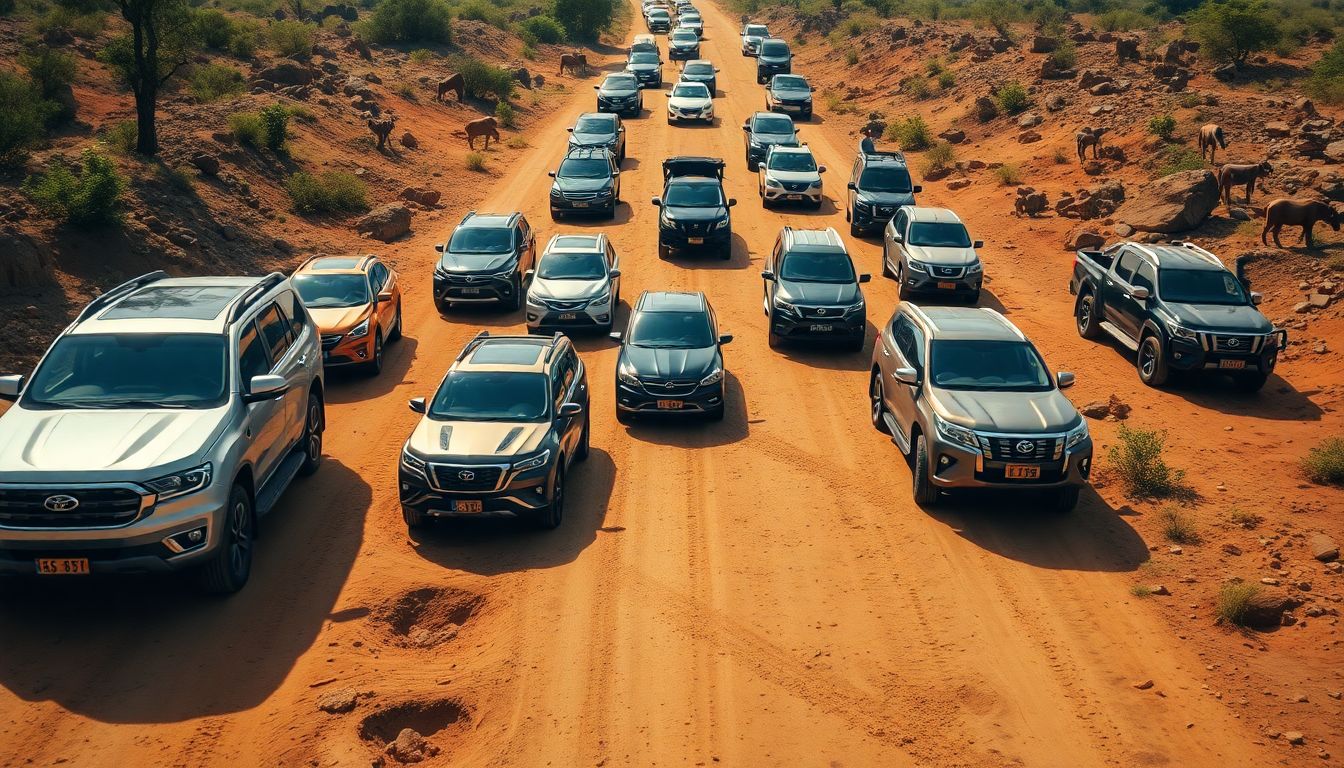Navigating the diverse terrain of Africa requires a vehicle designed to handle various challenges. From bustling urban streets to rugged rural paths, the right car can make all the difference. This guide explores the best cars suited for African roads, focusing on reliability, durability, ground clearance, safety, maintenance, and budget considerations.
The Challenges of African Roads: A Diverse Landscape
African roads can vary widely. You might encounter smooth highways, bumpy dirt tracks, rocky mountains, or muddy fields. Each environment poses unique challenges that vehicle owners must consider.
Choosing the Right Vehicle: Factors to Consider
When selecting a car for African roads, consider:
- Terrain: Urban vs. rural
- Climate: Rainy seasons, heat
- Maintenance: Availability of parts
- Fuel efficiency: Local fuel costs
Setting the Stage: What Makes a Car “Best” for African Roads?
The best vehicle is not just about brand or model but also how it performs in specific conditions. Ideal cars are reliable, affordable to maintain, and equipped to handle off-road adventures.
Reliability and Durability: The Cornerstone of African Roadworthiness
A dependable vehicle will get you through tough situations without frequent breakdowns.
Engine Power and Fuel Efficiency: Balancing Performance and Economy
Strong engines are essential for navigating hilly areas or overloaded routes. Look for cars that offer:
- Good horsepower: To tackle inclines
- Fuel efficiency: Economical, especially on long trips
Suspension Systems: Coping with Rough Terrain and Varying Road Conditions
A robust suspension is vital. It absorbs shocks from uneven surfaces, ensuring a comfortable ride. Options like solid axles and advanced shock absorbers can handle tough conditions better.
Proven Track Records: Brands and Models with a History of Success in Africa
Certain brands are known for their performance on African roads. Models like:
- Toyota Hilux: Renowned for toughness
- Nissan Patrol: Great off-road capabilities
- Ford Ranger: Popular for durability
Ground Clearance and Off-Road Capabilities: Conquering Challenging Terrains
High clearance allows cars to avoid obstacles like potholes or rocks.
Essential Ground Clearance: Navigating Potholes, Uneven Surfaces, and Water Crossings
Look for vehicles with at least 200mm of ground clearance. This offers protection against damage and keeps you steady on bumpy paths.
4×4 vs. 2WD: Analyzing Drivetrain Needs for Different Regions and Driving Styles
- 4×4 vehicles: Best for off-road adventures and rural areas.
- 2WD vehicles: Suitable for urban driving and well-paved roads.
Essential Off-Road Features: Differentials, Traction Control, and Recovery Points
Features like four-wheel drive, locking differentials, and recovery points enhance a vehicle’s off-road capabilities. These features help when navigating slippery terrains or getting stuck.
Safety and Security Features: Prioritizing Driver and Passenger Well-being
Safety should never take a back seat when choosing a vehicle.
Essential Safety Features: Airbags, ABS, and Electronic Stability Control
Modern cars must have:
- Multiple airbags for protection in accidents
- Anti-lock braking system (ABS) for better control
- Electronic stability control helps with skidding situations.
Security Features: Anti-theft Systems and Robust Construction for Added Safety
Look for features like alarm systems and sturdy frames that deter theft and increase safety.
Addressing Specific Safety Concerns: Examples of Common Challenges and Effective Solutions
Consider potential risks such as roadblocks or accidents. Reliable cars with good visibility and solid construction help minimize these risks.
Maintenance and Repair: Accessibility and Affordability
A vehicle that’s easy to maintain can save money in the long run.
Ease of Maintenance: Choosing Vehicles with Readily Available Parts
Select brands with a local presence. This ensures spare parts are easy to find, keeping repair costs lower.
Repair Costs and Accessibility: Factors to Consider for Long-Term Ownership
Research average repair costs in your area. Some cars are cheaper to fix, while others can drain your wallet quickly.
Local Mechanic Expertise: Utilizing and Building Relationships with Local Mechanics
Finding a good local mechanic can make a huge difference. They understand your area’s needs and can provide better service.
Budget and Practical Considerations: Finding the Right Vehicle for Your Needs
Understanding your budget helps narrow down choices effectively.
New vs. Used: Weighing the Pros and Cons
- New vehicles: Offer the latest features but cost more.
- Used cars: More affordable but may need more repairs.
Importation and Customs: Navigating Regulations and Associated Costs
If considering imported cars, research customs regulations. Costs can add up quickly, so factor in shipping fees and taxes.
Total Cost of Ownership: Calculating Long-Term Expenses
Consider costs like fuel, insurance, and maintenance. A cheaper car upfront may not be the best deal over time.
Conclusion: Making the Right Choice for Your African Adventure
Choosing the best car for African roads involves careful consideration of many factors.
Key Takeaways: Summarizing the Essential Factors for Selection
- Look for reliability and durability.
- Ensure adequate ground clearance.
- Prioritize safety features.
- Assess maintenance and budget implications.
Actionable Steps: Guiding Readers Through the Car-Buying Process
- Identify your driving needs.
- Research suitable models.
- Visit local dealers or trusted mechanics.
- Take test drives to feel the vehicle.
Resources for Further Research: Providing Helpful Links and References
For continued learning, explore resources like automotive reviews, safety ratings, and local automotive forums. Investigate all options to ensure you make the best choice.
When planning your next adventure, remember that the right car can turn a challenging trip into a successful journey.


